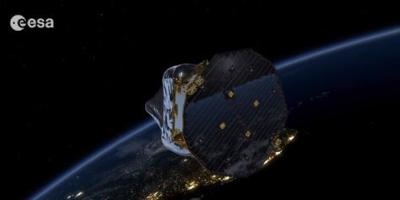Fri, Dec 04, 2015
Successful Launch Thursday Boosted Instrument Into Orbit
LISA Pathfinder, a European Space Agency (ESA) science spacecraft, designed and built by Airbus Defense and Space, has been successfully placed into orbit from the Kourou European spaceport in French Guiana. The Vega launcher, operated by Arianespace, flawlessly lifted-off on 03 December at 04:04 GMT and released LISA Pathfinder, 105 minutes later. Spacecraft controllers in the European Space Operations Center have received LISA Pathfinder’s first signals.

LISA Pathfinder will spend two weeks raising its orbit using a dedicated propulsion module, also built by Airbus Defense and Space, through six separate engine firings. After the final escape burn is performed and the health of the spacecraft module is confirmed, the propulsion module will be jettisoned, approximately 51 days after launch.
The spacecraft will continue on its journey to the first Lagrange point (L1) at 1.5 million km (approx 930,000 miles) from Earth. Its operational orbit is a 500,000km x 800,000km (approx 310,000 x 500,000 mile) Lissajous orbit around the L1 point. During the drift phase, the platform and the two spacecraft propulsion systems (Cold Gas and the NASA Colloidal micronewton thrusters) will be tested and verified.
24 days after the separation, the mission will begin with three weeks commissioning of the science payload including tests such as the release and capture of the test masses, and verification of the Drag Free and Attitude and Control System (DFACS). This will be followed by the six-month long main mission.
LISA Pathfinder is paving the way for a future large space observatory that ultimately will directly observe and precisely measure gravitational waves. ESA selected the gravitational universe science theme for its third Large Class L3 mission, for which a LISA-like mission is a leading candidate. Gravitational waves will allow astronomers to study our universe in a new way, and future telescope systems will be able to observe exotic sources, such as colliding super-massive black holes, as never before.

Airbus Defense and Space in the UK was chosen by the European Space Agency (ESA) to build the spacecraft and propulsion module and is responsible for delivering the integrated satellite. Airbus Defense and Space in Germany was chosen by ESA and the German Aerospace Center, DLR, to be the systems leader for the LTP, which was developed with contributions from European research institutes and companies.
(Source: Airbus news release. Images from file)
More News
With Testing Soon Complete, Launch Preparations Begin in Earnest Sierra Space's Dream Chaser has been put through the wringer at NASA's Glenn Armstrong Test Facility in Ohio, but w>[...]
Takeoff Roll The process whereby an aircraft is aligned with the runway centerline and the aircraft is moving with the intent to take off. For helicopters, this pertains to the act>[...]
“We’re proud of the hard work that went into receiving this validation, and it will be a welcome relief to our customers in the European Union. We couldn’t be mor>[...]
"Aircraft Spruce is pleased to announce the acquisition of the parts distribution operations of Wag-Aero. Wag-Aero was founded in the 1960’s by Dick and Bobbie Wagner in the >[...]
IDENT Feature The special feature in the Air Traffic Control Radar Beacon System (ATCRBS) equipment. It is used to immediately distinguish one displayed beacon target from other be>[...]
 Sierra Space Repositions Dream Chaser for First Mission
Sierra Space Repositions Dream Chaser for First Mission ANN's Daily Aero-Term (05.10.24): Takeoff Roll
ANN's Daily Aero-Term (05.10.24): Takeoff Roll Aero-News: Quote of the Day (05.10.24)
Aero-News: Quote of the Day (05.10.24) Aero-News: Quote of the Day (05.11.24)
Aero-News: Quote of the Day (05.11.24) ANN's Daily Aero-Term (05.11.24): IDENT Feature
ANN's Daily Aero-Term (05.11.24): IDENT Feature




